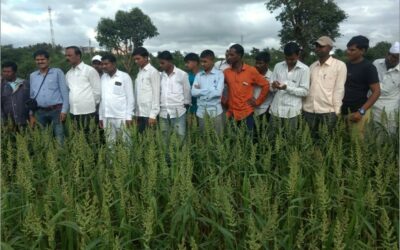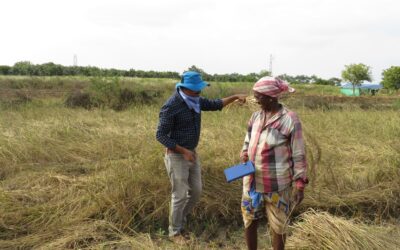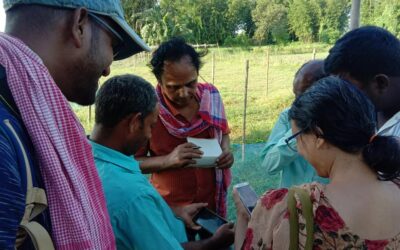Mahesh Acharya
Introduction
In December 2002, the Indian Government decided that it would grant academic institutes recognized by Central or the State Government to run low-power (50-Watt) Frequency Modulated (FM) radio stations. Of the many guidelines, the most important ones are that all the programs should be ‘ free to air’ basis, and programs that go on air must not violate the All India Radio broadcast code.
These radio stations can facilitate activities of Extension Services (ES), of around 28 State Agriculture Universities (SAU) or at least few of them. The dynamic interaction of the farmer communities with SAU’s has been well documented. With a powerful new communicative tool, the radio, the approach will be more effective and acceptable by the people.
There could be no other cheap and a simple technology than a small Community Radio Station (CRS) that could fit the budget compared to other ICT4D (information and communication technology for development). The CRS can broadcast programs for the farmers. This article discusses about scope of CRS as one of the ICT4D technology for rural communities.
Low power frequency modulated (FM) radio stations is a simple community radio station (CRS) technology with a powerful communicative tool, for the State Agricultural Universities and farmers. This two-way communication tool will enable the implementation of extension services tailored to specific region with greater success rate ensuring that the projects and schemes are participatory before implementation. Radio programs on improving crop production, pest control, environment, and other programs on health and sanitation can be broadcast regularly. Listening and participating in the activities of CRS could benefit farmer communities in villages within a radius of 15-20 kms around the radio station.
Stakeholders
The major stakeholders are the department of agriculture or University of Agricultural Sciences and local communities represented by schoolteacher, Self Help Groups, community based organizations etc. Coordination among the stakeholders is very essential for effective functioning of the system.
Procedure for setting up a CRS
Following are the steps to be followed in setting up and running a Community Radio Station by the Universities.
- Introducing the concept of radio station to the rural community
As a first step, the concept of community radio and its uses need to be introduced to the communities in a participatory manner. During the process, the farming communities and the University should jointly define a common mission statement or objective for setting up a radio station which will be the driving force behind all the physical (infrastructure need) and non-physical (training, decision, motivation, interest) activities.
- Selection of site for the radio station and obtaining license.
Th site for setting up the radio station has to be decided by the local communities. Before this, a license has to be obtained from the government to set up the CRS. The license application form is to be forwarded to the Ministry of Information and Broadcasting in triplicate through ministry of Human Resource Development, Government of India/State Government. There is no license fee, but licensee will have to pay 75,000 rupees as spectrum usage fee. A bank security of Rs 50,000 is to be deposited to ensure timely performance of the license agreement.
Within one year from the date of signing of the license agreement, the applicant must complete all necessary formalities. These include obtaining clearance from the Standing Advisory Committee on Radio Frequency Allocations (SACFA), setting up the necessary broadcast facilities and obtaining a Wireless Operating License from the Wireless Planning Commission Wing of Ministry of Communications and IT.
- Setting up studio with necessary equipment.
Three audio equipments are needed for a small CRS. (1) Recording equipment includes different types of mikes, portable tape recorders for outdoor recording, double sided audio cassette player, preferably with a compact disc recording and playing back facility. (2) Editing equipment includes studio console/mixer or multimedia computer. (3) The transmission equipment includes 50-Watts FM transmitter. There should be two transmitters as one of them will serve as back up in case of breakdown. A solar powered battery charger for backup is best advised for periods of power breakdown as it can cut electricity costs to some extent
- Training, selection of community broadcasters and finally going on air.
Training is important to gain the skills of program production and equipment handling. Women and children from the communities should be encouraged to take part in the training. Training should be provided on different modules on technical and program production so as to enable them to operate the portable cassettes recorders; use mikes different types of mikes for programs such as interview, music, and discussion or a out door recording. A trip to a radio station is important to understand the business of broadcasting. Radio clubs that are so common in India is perhaps the ideal place to select people for training, since the members have interest in radio these should be selected for training and team members with University people. They can also help to generate funds.
Cost
The estimated cost of setting up and running a CRS is approximately Rs 10 lakhs depending on cost of equipment and its make. This does not include the recurring expenses like electricity bill, honorarium for field reporters, salary of the staff and cassette tapes.
Sustenance of the CRS
Long-term sustenance of the radio station is very important. As per guidelines the station cannot generate revenue by sponsoring programs or through advertisements like All India Radio. Therefore the CRS has to sustain on funding from external agencies like NGOs or communities themselves. The radio station can also generate funds by producing audio programs for cooperatives, banks, and other institutes like NGO.
For more information, please check http://mib.nic.in and www.bel-india.com
Mahesh Acharya, Field Researcher, CKS Consulting Pvt. Ltd, B-014 Natasha Golf View Apartments, Domlur, Bangalore – 71; email: mahesh@ict4d.info”









